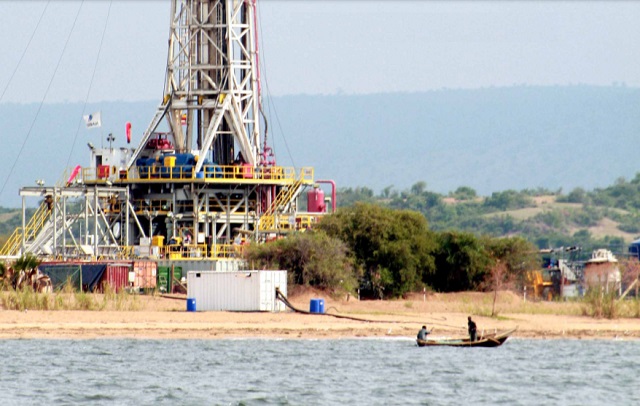
Hoima, Uganda | THE INDEPENDENT | The discovery of oil in the Albertine graben is altering the socio-economic profile of a once-sleepy town of Hoima now dubbed as oil city.
While the discovery of oil in Albertine has raised fear of a likely resource curse, some residents in Hoima and Buliisa districts say they are witnessing some transformation even before oil comes out of the ground.
The urban landscape especially in Hoima city has undergone rapid changes, including the influx of migrants. For Hoima’s ambitious new entrepreneurs like Peter Mayanja, there is opportunity here. “Everyone is going to gain.”
“Anytime I’m sure that everybody is going to enjoy from this oil and the developments which are coming in,” says Mayanja, a real estate dealer and owner of Farm Bridge Investments. “I don’t know where people are coming from. People are renting houses. It can take you a week to find a house for rent. Lots of houses are being constructed but they are booked.”
It is getting difficult to find a plot of land mostly in the center of Hoima city, reveals Mayanja, whose office is located in former slum Kiryatete.
Before oil was discovered in 2006, Hoima had just a handful of hotels from the likes of Kolping and Nsamo hotel. Big hotels like Miika resort, Kontiki and Hoima resort are up and running way before oil taps open.
Grace Kojo, the founder of Kontiki hotel agrees that the discovery oil for Hoima has brought fortune to Hoima and Bunyoro.
“I think it is because of oil that we have a number of buildings and hotels Hoima. It is also possible that they are speculating for the oil industry. I think and believe that oil is not going to be a curse for Hoima,” says Kojo whose hotel located about three kilometers out of Hoima has been a popular destination for expatriate oil and gas workers because of meeting the so called oil and gas standards.
On the roads leading to Total’s Tilenga project in Buliisa and CNOOC’s Kingfisher in Kikuube, billboards advertise plots of land. One of those offers five acres of land going for 700 million shillings.
For Buliisa district chairperson Fred Lukumu, oil and gas has ushered in development and more is expected. Patients don’t have to take an 82-kilometer journey to Hoima thanks to a general hospital constructed by Tullow Oil.
“They helped us. At least we now have one general hospital. Although very under facilitated. It is overwhelmed by the high number of patients given that there is a lot of influx of immigrants in Buliisa especially now that the oil sector booming,” said Lukumu.
But Fred Lukumu is asking the government and the oil companies for more in form of a technical school.
“We need to help our people to get preliminary elementary skills. Otherwise, we don’t have even welders here. We don’t even have people to work with private companies employed here,” said Lukumu.
Some years back, the road from Hoima to Buliisa was dusty with no layer of tarmac, Buliisa RDC Ahebwa Longino Byagagaire said.
“From Hoima, Butiaba-Wanseko, they are tarmacking a111 kilometer road. Then we have one connecting from Biiso to Masindi which is 43 kilometers, and there is one from Kisanja to Masindi through the park to Para. Government also gave us 9.9 kilometers of tarmac with in our town council,” said Byagagaire.
“Almost eighty percent of Murchison Falls National Park is within Buliisa district. Murchison Falls across the Nile used to be a ferry but now they put a bridge. So when you are crossing to West Nile, you cross with your car,” he added.
While some residents of Bulisa have not physically touched oil money, some feel a lot has changed. “To me, the way Buliisa was looking like before the oil exploration is not the way it is looking like today. Because it would take us over two hours to travel a distance of about 45 kilometers to Hoima, but now it takes thirty minutes or less,” said Zephaniah Eikiriza, a resident in Biso township. “I will not say I have seen the oil directly but now I have started seeing the signs of the oil which was found in Buliisa,” he adds.
Before oil was discovered in the Albert area, Buliisa used to face attacks from suspected criminals crossing from DRC. But now the Ugandan side of the lake is patrolled by a Marine brigade based in Watembo. There is also oil and gas police in both Hoima and Buliisa. The oil and gas installations are generally guarded by SFC, a specialized component of the Uganda People’s Defense Forces (UPDF).
As the site for construction of the refinery is being prepared, the Chief of Defense Forces General Wilson Mbadi said the UPDF will beef up deployment in Buliisa and neighboring areas.
Within Buliisa town council stands a 100,000 cubic liter water tank connected with pipes covering about a 4.8 kilometer stretch transmission line from Katanga-Wasenko in Lake Albert to Kirama.
The Kirama water project constructed by Total as part of Corporate Social Responsibility, also supported by the government through the Petroleum Authority of Uganda has come with great relief to residents of Kigwera and Kisanja thanks to oil developments here.
“Because this is an urban setting, we are shifting way from having the borehole setting. In the long run, we shall be shifting to National Water and Sewerage levels when oil production begins,” said Ramose Ahebwa, who manages the project
“We have also added another kilometer of piped water from Wanseko town to Kigwera health centre II to cater for our sick mums, dads and selves. Thanks to Total, now people of Kigwera are getting safe and clean water,” he said.
******
URN
The post Oil curse or no curse: Life is changing in Hoima and Buliisa districts appeared first on The Independent Uganda:.
from The Independent Uganda: https://ift.tt/3FHrZ0m
0 Comments